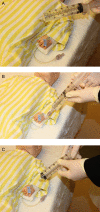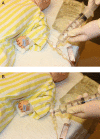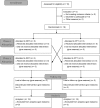Rapid paediatric fluid resuscitation: a randomised controlled trial comparing the efficiency of two provider-endorsed manual paediatric fluid resuscitation techniques in a simulated setting
- PMID: 24993757
- PMCID: PMC4091513
- DOI: 10.1136/bmjopen-2014-005028
Rapid paediatric fluid resuscitation: a randomised controlled trial comparing the efficiency of two provider-endorsed manual paediatric fluid resuscitation techniques in a simulated setting
Abstract
Objectives: Manual techniques of intravascular fluid administration are commonly used during paediatric resuscitation, although it is unclear which technique is most efficient in the hands of typical healthcare providers. We compared the rate of fluid administration achieved with the disconnect-reconnect and push-pull manual syringe techniques for paediatric fluid resuscitation in a simulated setting.
Methods: This study utilised a randomised crossover trial design and enrolled 16 consenting healthcare provider participants from a Canadian paediatric tertiary care centre. The study was conducted in a non-clinical setting using a model simulating a 15 kg child in decompensated shock. Participants administered 900 mL (60 mL/kg) of normal saline to the simulated patient using each of the two techniques under study. The primary outcome was the rate of fluid administration, as determined by two blinded independent video reviewers. We also collected participant demographic data and evaluated other secondary outcomes including total volume administered, number of catheter dislodgements, number of technical errors, and subjective and objective measures of provider fatigue.
Results: All 16 participants completed the trial. The mean (SD) rate of fluid administration (mL/s) was greater for the disconnect-reconnect technique at 1.77 (0.145) than it was for the push-pull technique at 1.62 (0.226), with a mean difference of 0.15 (95% CI 0.055 to 0.251; p=0.005). There was no difference in mean volume administered (p=0.778) or participant self-reported fatigue (p=0.736) between techniques. No catheter dislodgement events occurred.
Conclusions: The disconnect-reconnect technique allowed for the fastest rate of fluid administration, suggesting that use of this technique may be preferable in situations requiring rapid resuscitation. These findings may help to inform future iterations of paediatric resuscitation guidelines.
Trial registration number: This trial was registered at ClinicalTrials.gov [NCT01774214] prior to enrolling the first participant.
Keywords: ACCIDENT & EMERGENCY MEDICINE; INTENSIVE & CRITICAL CARE; TRAUMA MANAGEMENT.
Published by the BMJ Publishing Group Limited. For permission to use (where not already granted under a licence) please go to http://group.bmj.com/group/rights-licensing/permissions.
Figures



Similar articles
-
Study protocol for a randomised controlled trial comparing the efficiency of two provider-endorsed manual paediatric fluid resuscitation techniques.BMJ Open. 2013 Mar 21;3(3):e002754. doi: 10.1136/bmjopen-2013-002754. BMJ Open. 2013. PMID: 23524045 Free PMC article.
-
Evaluating the test re-test reliability and inter-subject variability of Health Care Provider manual fluid resuscitation performance.BMC Res Notes. 2014 Oct 15;7:724. doi: 10.1186/1756-0500-7-724. BMC Res Notes. 2014. PMID: 25315062 Free PMC article.
-
Factors affecting pediatric isotonic fluid resuscitation efficiency: a randomized controlled trial evaluating the impact of syringe size.BMC Emerg Med. 2013 Jul 24;13:14. doi: 10.1186/1471-227X-13-14. BMC Emerg Med. 2013. PMID: 23883424 Free PMC article. Clinical Trial.
-
Fluid resuscitation therapy for paediatric sepsis.J Paediatr Child Health. 2016 Feb;52(2):141-6. doi: 10.1111/jpc.13085. J Paediatr Child Health. 2016. PMID: 27062617 Review.
-
Is There an Optimum Duration of Fluid Bolus in Pediatric Septic Shock? A Critical Appraisal of "Fluid Bolus Over 15-20 Versus 5-10 Minutes Each in the First Hour of Resuscitation in Children With Septic Shock: A Randomized Controlled Trial" by Sankar et al (Pediatr Crit Care Med 2017; 18:e435-e445).Pediatr Crit Care Med. 2018 Apr;19(4):369-371. doi: 10.1097/PCC.0000000000001459. Pediatr Crit Care Med. 2018. PMID: 29369077 Review.
Cited by
-
Improving Aseptic Technique During the Treatment of Pediatric Septic Shock: A Comparison of 2 Rapid Fluid Delivery Methods.J Infus Nurs. 2019 Jan/Feb;42(1):23-28. doi: 10.1097/NAN.0000000000000307. J Infus Nurs. 2019. PMID: 30589717 Free PMC article.
-
Improving fluid resuscitation in pediatric shock with LifeFlow®: a retrospective case series and review of the literature.Open Access Emerg Med. 2019 Apr 24;11:87-93. doi: 10.2147/OAEM.S188110. eCollection 2019. Open Access Emerg Med. 2019. PMID: 31118839 Free PMC article.
-
Paediatric trauma resuscitation: an update.Eur J Trauma Emerg Surg. 2016 Jun;42(3):297-301. doi: 10.1007/s00068-015-0614-9. Epub 2015 Dec 22. Eur J Trauma Emerg Surg. 2016. PMID: 26696087 Free PMC article. Review.
References
-
- Yager P, Noviski N. Shock. Pediatr Rev 2010;31:311–18 - PubMed
-
- McKiernan CA, Lieberman SA. Circulatory shock in children: an overview. Pediatri Rev 2005;26:451–60 - PubMed
-
- Management of shock. In: Chameides L, Samson RA, Schexnayder SM, Hazinski MF, eds. Pediatric advanced life support provider manual. Dallas, TX: American Heart Association, 2011:85–108
-
- Shock. Advanced trauma life support for doctors student manual. 8th edn. Chicago, IL: American College of Surgeons Committee on Trauma, 2008:55–71
-
- Pediatric Trauma. Advanced trauma life support for doctors student course manual. 8th edn. Chicago, IL: American College of Surgeons Committee on Trauma, 2008:225–46
Publication types
MeSH terms
Associated data
LinkOut - more resources
Full Text Sources
Other Literature Sources
Medical
